Equity Initiatives Unit - Equitable Classroom Practices
Short Takes
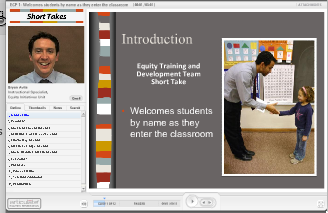 Practice 1: Welcomes Students by name as they enter the classroom
Practice 1: Welcomes Students by name as they enter the classroom“McKinley, in his study of Seattle Public Schools, found that, ‘Teachers who were successful in helping black students achieve at high levels were able to build positive, respectful relations with and demonstrate caring for their students.’ That begins with the correct naming of names at the classroom door.”
Equity Training and Development Team. (2007). A place where everyone knows your name. Retrieved November 2008, from MCPS website: https://www.montgomeryschoolsmd.org/departments/development/teams/diversity/diversity.shtm
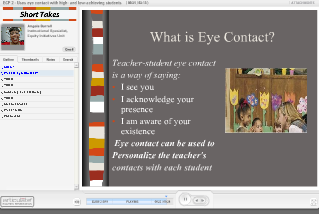 Practice 2: Uses eye contact with high- and low-achieving students
Practice 2: Uses eye contact with high- and low-achieving students“Harris Cooper, in his groundbreaking and extensive research on the connection between teacher expectations and student performance, found that teachers varied the amount of eye contact they made with their students, depending on how they perceived the ability of those students. Teachers appeared to create a ‘warmer socio-emotional atmosphere’ in their classroom for those students that they perceived as bright. A prime element of this atmosphere was that teachers were observed to lean toward brights and look them in the eyes more frequently than they did with students that they perceived to be slow.”
Equity Training and Development Team. (2007). Eye Contact. Retrieved November 2008, from MCPS website: https://www.montgomeryschoolsmd.org/departments/development/teams/diversity/diversity.shtm
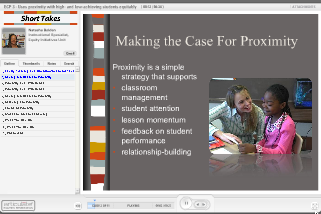 Practice 3: Uses proximity with high- and low-achieving students equitably
Practice 3: Uses proximity with high- and low-achieving students equitably“Ladson-Billing notes, ‘Although it has been suggested that teachers unconsciously favor those students perceived to be most like themselves in race, class, and values, culturally relevant teaching means consciously working to develop commonalities with all the students.’ Part of this consciousness should include teacher self-monitoring of their use of proximity, being certain not to positively gravitate to students like them for social contact and academic reinforcement and, for disciplinary reasons, not to negatively hover over students who may differ from them.”
Equity Training and Development Team. (2007). Proximity. Retrieved November 2008, from MCPS website: https://www.montgomeryschoolsmd.org/departments/development/teams/diversity/diversity.shtm
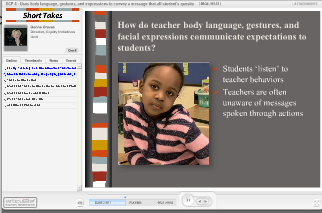 Practice 4: Uses body language, gestures, and expressions to convey a message that all student’s questions and opinions are important
Practice 4: Uses body language, gestures, and expressions to convey a message that all student’s questions and opinions are important“Much of educators’ decision-making on the potential and realized achievement of students of color is dependent on communication abilities (their own and the students’). If students are not very proficient in school communication, and teachers do not understand or accept the students’ cultural communication styles, then their academic performance may be misdiagnosed or trapped in communicative mismatches. Students may know much more than they are able to communicate, or they may be communicating much more than their teachers are able to discern…Knowledge about general communication patterns among ethnic groups is helpful, but it alone is not enough. Teachers need to translate it to their own particular instructional situations.”
Gay, G. (2000). Culturally responsive instruction: Theory, research, & practice. New York: Teachers College Press. p. 78 & p. 109.
 Practice 5: Arranges the classroom to accommodate discussion
Practice 5: Arranges the classroom to accommodate discussion“An inviting classroom uses the arrangements of desks to enhance the interpersonal relationships between teacher and the student. . . . Students must be able to relate in a positive way to each other so that communication occurs not only between the teacher and students in a particular vicinity, but also between student and student. This permits a sense of connection and collaboration. As the authors pointed out in their review of physical space, one student unable to participate in the group can alert the dynamic flow of personalities within the classroom and have an effect on the behavior of students.”
Shade, B. J. (2004). Creating culturally responsive classrooms. Washington, DC: American Psychological Association. p. 43.
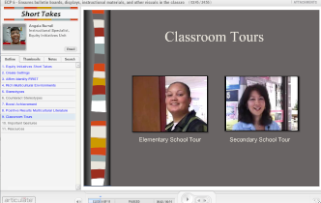 Practice 6: Ensures bulletin boards, displays, instructional materials, and other visuals in the classroom reflect the racial, ethnic, and cultural backgrounds represented by students
Practice 6: Ensures bulletin boards, displays, instructional materials, and other visuals in the classroom reflect the racial, ethnic, and cultural backgrounds represented by students“The physical structure of schools also gets in the way of educational equity . . . The lack of relevant and culturally appropriate pictures, posters, and other instructional materials as well as the lifeless and institutional colors of green and gray on the walls, and we are left with environments that are scarcely inviting centers of learning . . . The physical environment of schools can reflect the expectations that educators have of the capabilities of students.”
Nieto, S. (2000). Affirming diversity: the sociopolitical context of multicultural education. Third Edition. New York, Addison Wesley Longman, Inc. pp. 102–103 & p. 362.
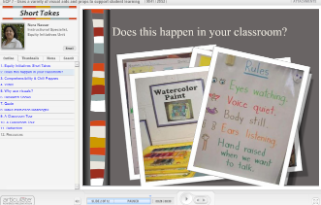 ECP 7: Uses a variety of visual aids and props to support student learning
ECP 7: Uses a variety of visual aids and props to support student learning“For children of color and families of immigrants, their initial assessment of their acceptance depends on whether or not they perceive pictures, symbols, or other visual representations that remind them of their homes, communities, and values. An inviting classroom focuses on the use of color, physical arrangement of space, lighting, and sound to attract students to the learning process.”
Shade, B. J. (2004). Creating culturally responsive classrooms. Washington, DC: American Psychological Association. p. 43.
 ECP 8: Learns, uses, and displays some words in students’ heritage language
ECP 8: Learns, uses, and displays some words in students’ heritage language“Drawing on students’ languages in the classroom enables English language learners to make special contributions, enhances their participation and academic achievement, and broadens the linguistic awareness of all students.”
Cummins, J., et al. (2005). Affirming identity in multilingual classrooms. Educational Leadership Vol. 63, No. 1, pp. 38–43.
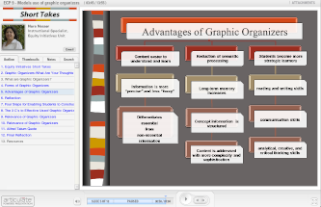 ECP 9: Models use of graphic organizers
ECP 9: Models use of graphic organizers“Graphic organizers should allow the incorporation of student insight and knowledge. Some students, particularly those learning English as a second language, or those whose background inclines them more to the aural and visual, rather than the written and read, respond better to the inclusion of their social iconography, such as music, decals, graffiti, and TV imagery. It is precisely those kinds of representations that effective graphic organizers can include.”
Hill, C. (March 2003). Integrating digital tools into a culturally diverse curriculum: An assessment model for the pacesetter program. Teachers College Record. Vol. 105, Issue 2, p. 278–296.
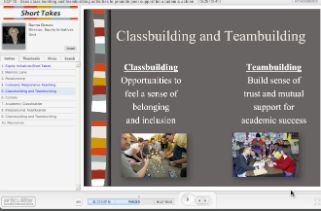 ECP 10: Uses class building and teambuilding activities to promote peer support for academic achievement
ECP 10: Uses class building and teambuilding activities to promote peer support for academic achievement“One way that teachers can promote sensitivity to diversity is by using class building and teambuilding activities in a systematic and strategic manner. At the outset of the year, and on a routine basis, a variety of class building and teambuilding activities should be used to build and reinforce supportive peer relationships. Laurie Kagan (2002) recommends the use of teambuilding activities on a biweekly basis to promote group cohesiveness and facilitate group performance. Class building activities are recommended weekly to foster classroom community.” Bureau of Instructional Support and Community Services. (2002).
Designing lessons for the diverse classroom: A handbook for teachers. Retrieved January 2009 http://www.cpt.fsu.edu/ese/pdf/dsinlssn.pdf
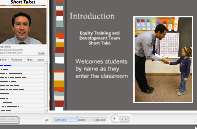
Practices 1-10
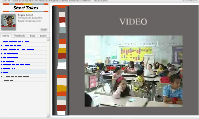
Practices 11-20

Practices 21-27